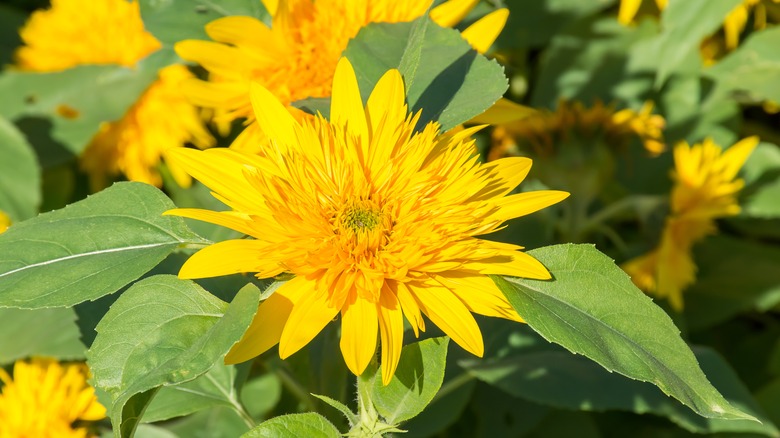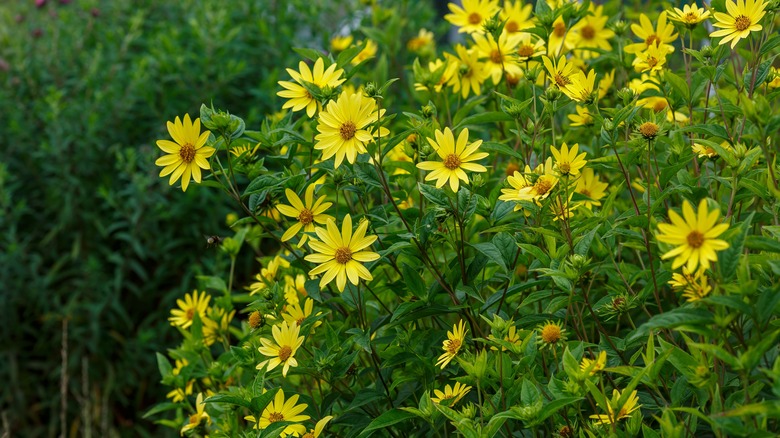The first Saturday of August is known as National Sunflower Day! By this time, many sunflower species are in full bloom, showing off their incredible yellow-orange heads atop tall stems. Some don’t realize that there is more than one type of sunflower. In fact, there are 150 distinct species, and a large chunk of them are native to the United States. Most species also have countless varieties and cultivars that show off different flower colors, growth habits, and foliage types.
In early and mid-August, people are out in droves to see the iconic flowers at annual festivals open everywhere. From Pennsylvania to Washington, farms across the U.S. invite locals to check out their stunning blooms. There are many ways to appreciate sunflowers, and if you’re unable to pamper the beauties growing in your garden, try viewing some planted en masse in your area. Until then, learning how to identify the different species is worthwhile. You can read about them below.
1. Common sunflower

The common sunflower (Helianthus annuus) is likely the one you imagine when you hear the name. It produces large flowers with a brown-black center and many long yellow petals. A good companion plant, this species attracts many pollinator species to the garden. Additionally, the common sunflower is very easy to grow because of its tolerance for drought, neglect, and poor soil.
Bloom Season: Summer to fall
USDA Growing Zone: 2 to 11
Growing Conditions: Full sun
Soil Type: Rich, loose, and well-draining
Size: 5 to 10 feet tall and 2 feet wide
2. Sunchoke

Sunchokes (Helianthus tuberosus), also known as Earth apples and Jerusalem artichokes, are root vegetables that produce edible tubers, similar to potatoes. The flavor has been compared to nutty water chestnuts, and they are typically boiled and mashed before eating. However, they have no poisonous characteristics, so they may be eaten raw as well.
Bloom Season: Summer and fall
USDA Growing Zone: 3 to 9
Growing Conditions: Full sun to partial shade
Soil Type: Well-draining and slightly alkaline
Size: 6 to 10 feet tall and 3 to 5 feet wide
3. Narrow-leaf sunflower

AngieC333/Shutterstock
The narrow-leaf sunflower (Helianthus angustifolius) looks like a smaller and more dainty version of the common sunflower. It still shows off yellow petals and a brown center, but they are shaped more similarly to common daisies. They are also part of the majority of sunflower species that grow as perennials instead of annuals. Make sure to provide yours with plenty of moisture and shade it from scorching direct sunlight.
Bloom Season: Fall
USDA Growing Zone: 5 to 9
Growing Conditions: Partial shade
Soil Type: Moist and loamy
Size: 5 to 8 feet tall and 2 to 4 feet wide
4. Appalachian sunflower

Wirestock Creators/Shutterstock
Appalachian sunflowers (Helianthus atrorubens) are, of course, native to the warmer parts of the Appalachian region. They typically grow in coarse and gritty soil in woodlands and road banks. These somewhat wild sunflowers grow much shorter than common sunflowers, only reaching 4 feet tall in maturity. However, they still show off the gorgeous foliage and flowers that make this genus so ornamental.
Bloom Season: Summer to fall
USDA Growing Zone: 6 to 8
Growing Conditions: Full sun to partial shade
Soil Type: Gritty and well-draining
Size: 3 to 4 feet tall and 1 to 3 feet wide
5. Fewleaf sunflower

manfredrichter/Shutterstock
The shortest species of sunflowers native to the U.S. are called fewleaf sunflowers (Helianthus occidentalis). These 2 to 3-foot tall flowers are known for having very few leaves, hence their common name. The blooms themselves are also star-shaped and quite small. You can grow the fewleaf sunflowers in the same way you care for other Helianthus species. They just need full sun and a bit of consistent moisture applied to their well-draining soil.
Bloom Season: Summer
USDA Growing Zone: 3 to 9
Growing Conditions: Full sun
Soil Type: Well-draining
Size: 2 to 3 feet tall and 1 to 2 feet wide
6. Giant sunflower

Gerrit Lammers/Shutterstock
The giant sunflower (Helianthus giganteus) is a tall and branching plant that is named for its stems that can reach up to 12 feet tall in ideal conditions. Though the name might lead you to expect the sunflower to bear giant flower heads, this is not the case. The blooms that appear in the summer are fairly small, but there will be many of them.
Bloom Season: Summer to fall
USDA Growing Zone: 3 to 9
Growing Conditions: Full sun to partial shade
Soil Type: Evenly moist and well-draining
Size: 8 to 12 feet tall and 4 to 6 feet wide
7. Forest sunflower

Reallyice/Shutterstock
The forest sunflower (Helianthus decapetalus), which is also referred to as the 10-petal sunflower, roughleaf sunflower, and thinleaf sunflower, is a great species that grows in somewhat shaded and moist locations. Their blooms are stunning as they not only feature the typical long yellow ray florets but also many small disk florets that are also bright yellow.
Bloom Season: Summer to fall
USDA Growing Zone: 4 to 9
Growing Conditions: Full sun to partial shade
Soil Type: Moist, loamy, and well-draining
Size: 5 feet tall and 3 feet wide
8. Ashy sunflower

Danita Delimont/Shutterstock
Named after its rough and grayish leaves, the ashy sunflower (Helianthus mollis) is a low-maintenance plant that needs only well-draining soil, some sun, and little water to survive. It grows naturally in prairies and wooded areas, as well as in rocky fields, groves, and along roadsides. Bird species love to snack on the seeds offered by this flower, but they can wreak havoc on the blooms, making them much less ornamental in the garden.
Bloom Season: Summer
USDA Growing Zone: 4 to 9
Growing Conditions: Full sun
Soil Type: Well-draining
Size: 2 to 4 feet tall and 1 to 3 feet wide
9. Resindot sunflower

SheriLee0428/Shutterstock
Resindot sunflowers (Helianthus resinosus) produce stems bearing several large flower heads in the summer and fall. They are easily identified by the many yellow dots littering its foliage and some of its flowers. The marks are made of resin produced by the plant, hence its common name. Keep in mind that this species can spread rapidly through self-seeding and suckers, so pay close attention to it.
Bloom Season: Summer to fall
USDA Growing Zone: 7 to 9
Growing Conditions: Full sun to partial shade
Soil Type: Evenly moist and well-draining
Size: 6 to 10 feet tall and 1 to 3 feet wide
10. Showy sunflower

PT Pictures/Shutterstock
Among the most beautiful of Helianthus species is the showy sunflower (Helianthus laetiflorus). This one typically blooms for only a couple of months, but its show is spectacular. Its flowers have vibrant yellow petals and dark centers that make the color stand out even more. By the time this sunflower blossoms, the stalk will likely be 6 feet tall, so you can see the flowers from quite a distance.
Bloom Season: Late summer
USDA Growing Zone: 3 to 8
Growing Conditions: Full sun to partial shade
Soil Type: Moist and rich
Size: 3 to 6 feet tall and 2 to 4 feet wide
11. Small-headed sunflower

Flower_Garden/Shutterstock
With a flower head of only 1 to 3 inches in diameter, the small-headed sunflower (Helianthus microcephalus) is aptly named. Compared to the sometimes 8-inch blooms of the common sunflower, this one looks much more delicate. It’s perfect for use in a cottage garden or mixed with other flowers in a border.
Bloom Season: Summer to early fall
USDA Growing Zone: 4 to 8
Growing Conditions: Full sun to partial shade
Soil Type: Evenly moist and well-draining
Size: 4 to 6 feet tall and 2 to 3 feet wide
12. Willowleaf sunflower

Anna Gratys/Shutterstock
Willowleaf sunflowers (Helianthus salicifolius) are known for their long and thin leaves that droop like a willow tree. They are often used in bouquets and floral arrangements for their unique foliage and medium-sized flowers that are rarely larger than 3 inches in diameter. However, the sunflowers can be planted in the garden and grown with ease due to their low-maintenance habit.
Bloom Season: Late summer to early fall
USDA Growing Zone: 4 to 9
Growing Conditions: Full sun
Soil Type: Well-draining
Size: 8 to 10 feet tall and 1 to 3 feet wide
13. Woodland sunflower

meunierd/Shutterstock
Woodland sunflowers (Helianthus divaricatus) grow just a little shorter than most of the tall sunflower species in this collection. They are great for planting in wildlife and native gardens that are looking to host and feed local birds and insects. In particular, quail, Silvery Checkerspot, and mourning doves are attracted to the flower’s seeds.
Bloom Season: Late summer to fall
USDA Growing Zone: 3 to 9
Growing Conditions: Partial shade
Soil Type: Well-draining
Size: 2 to 7 feet tall and 1 to 3 feet wide
14. Schweinitz’s sunflower

Al More/Shutterstock
Schweinitz’s sunflower (Helianthus schweinitzii) is a rare species of sunflower that is hardly ever grown in the garden. Discovered in the earlier part of the 1800s, it now only grows in parts of North and South Carolina. The plants bloom later in the season, typically beginning in August and lasting until the first frost. Like other sunflowers, it supports migrating Silvery Checkerspot populations as well as some pollinator species.
Bloom Season: Late summer to fall
USDA Growing Zone: 7 to 9
Growing Conditions: Full sun
Soil Type: Well-draining
Size: 3 to 12 feet tall and 3 to 6 feet wide
15. Beach sunflower

Chase D’animulls/Shutterstock
The beach sunflower (Helianthus debilis) is one of the few sunflowers that can be used as ground cover in a landscape. Growing to less than 3 feet tall, the native annual flowers self-seed and spread over an area quite rapidly. Despite being an annual plant, they also tend to reemerge year after year due to their self-seeding habit.
Bloom Season: Year-round
USDA Growing Zone: 8 to 11
Growing Conditions: Full sun
Soil Type: Sandy and well-draining
Size: 1 to 3 feet tall and 2 to 8 feet wide
16. Maximilian sunflower

f.maliki/Shutterstock
Maximilian sunflowers (Helianthus maximiliani) are perennial flowers native to the prairies of the United States. They are sometimes hard to distinguish from common sunflowers, especially when they have reached maturity. But, some details can identify them. Unlike your usual sunflower, Maximilian’s blooms later, tolerates dry soil more easily, and has smaller flowers.
Bloom Season: Fall
USDA Growing Zone: 4 to 9
Growing Conditions: Full sun
Soil Type: Average and well-draining
Size: 3 to 10 feet tall and 2 to 4 feet wide




